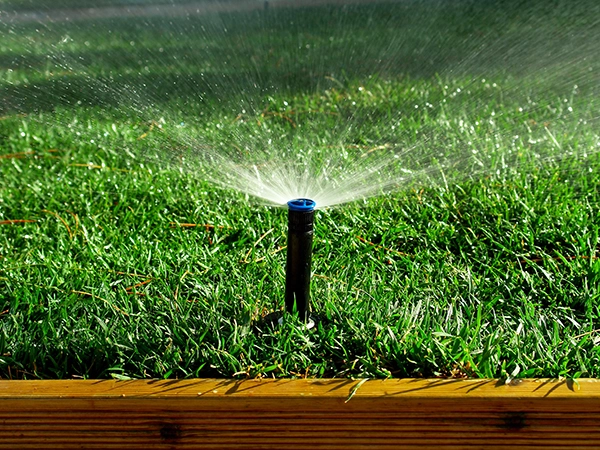While all North Texas grass types have similar watering needs, there are a few differences you’ll be wise to make note of depending on what type of grass bed you have.
Before we discuss the specifics, here are a few universal tips:
- Water deeply rather than frequently. While the optimal amount of watering may vary a bit from one grass to another, there are benefits to watering more at once, rather than a little bit at a time. Deep watering helps establish a strong root system, by allowing brief dry spells that encourage the roots to reach further into the topsoil.
- Don’t water at night. Doing so increases the chances of lawn diseases setting in, because fungus thrives in moist, dark spaces. While we cannot control whether or not it rains at night, we can protect our grass by choosing not to water it after dark.
- Don’t water when it’s really hot. This can be tricky in the summer season, which is why we suggest early morning irrigation. Watering your lawn in the heat of the day means a portion of that moisture simply evaporates before soaking into the soil.
- Use a rain gauge to monitor how much water your grass is getting, both from rain and from your irrigation schedule. We’re about to explore exactly how much water each grass type needs, so it’s important that you have a way to measure how much water your sprinklers are providing.
Measuring Your Irrigation
When using a rain gauge, you will need to do a “test run” of sorts, so you know how long it takes your particular sprinkler system to provide a certain amount of irrigation. This is true both for in-ground and hosed sprinklers.
If you do not have a rain gauge, don’t worry. Simply mark a mason jar with a permanent marker. Make a line for 1/2 inch, 3/4 inch, 1 inch, and 1 1/4 inches. This way, it’s easy to monitor the amount of water being provided, without literally walking into the sprinkler’s “line of fire” and getting wet.
RELATED TIP: Summer Watering Schedule for North Texas Lawns
You may need to perform a test at multiple different places in your yard. This is because some areas may need more or less water than the main portion of your grass. Examples of that include deeply shaded areas, sloped portions of your landscape, and areas where the sprinklers are also watering trees and shrubs.
Monitor your rain gauge (or your mason jar) while watering, so you know how long it takes for your sprinkler system to provide the correct amount of irrigation. From there, you will be able to set your automatic sprinkler accordingly. If you have a hose-attached sprinkler, you can simply move it according to the time it takes to adequately water a certain area of your lawn.
Keeping the rain gauge or mason jar in place has additional benefits, even if you’ve already sorted out a healthy irrigation schedule. When it rains, you may want to cut back on the amount of watering you do that week. Knowing how much water your lawn has already received will let you know how much you can reduce your regular watering time.
Now let’s take a look at the specifics for Bermuda grass, Common Bermuda grass, St. Augustine grass, and Zoysia grass. Learn more about why these are the Best Grass Types for North Texas Heat!
Bermuda Grass
Most Bermuda grasses are a hybrid, which is what distinguishes them from “commom” Bermuda grass, which is discussed below. It does well in our region because it thrives in warm climates. It generally requires about 1 inch of water per week. However, Bermuda is known for being drought-hardy.
During times when watering restrictions are in place, your Bermuda grass can sustain 1/2 inch of water for a few weeks, with no damage. The first sign of dehydrated Bermuda grass is the blades bowing down a bit. Watching for this can help prevent it from getting dry enough to go yellow.
RELATED TIP: Best Grass Types for North Texas Heat
Common Bermuda Grass
This grass type may be the lowest-maintenance grass that does well in the North Texas region. It is less expensive than its counterpart, though equally as sturdy.
Common Bermuda grass tends to develop a hardy root system that allows it to withstand fairly long periods of drought. It thrives on 1/2-1 inch of water per week, and can go the longest between waterings before it begins to wilt.
Zoysia Grass
Zoysia is a wonderfully versatile grass that does really well throughout the state of Texas. While it may not withstand longer droughts quite as well as Bermuda grass, it is still fairly low maintenance with regards to irrigation.
Most of the time, Zoysia grass requires about 0.75 of an inch per week of water in order to stay healthy. Once again, we encourage you to use a rain gauge in order to ensure you’re providing the right amount of water.
St. Augustine Grass
This grass type is great for a variety of yards, both sunny and shady. It’s a good option for areas with mature trees. Although it’s fairly drought tolerant, like the others, St. Augustine requires a bit more watering than the others.
1.25 inches per week is the optimal amount of irrigation for St. Augustine. While we do encourage you to water deeply rather than frequently, we understand that water restrictions can play a role in your irrigation schedule. If you need to split the 1.25 inches into two sessions, that works just fine.
Visit our Services page to learn more about how Evergreen Lawn and Landscaping can help you keep your yard beautiful!



Comments (0)
Thanks for your comment!
Thanks for your feedback! Your comments have been successfully submitted! Please note, all comments require admin approval prior to display.
Error submitting comment!
There is a problem with your comment, please see below and try again.